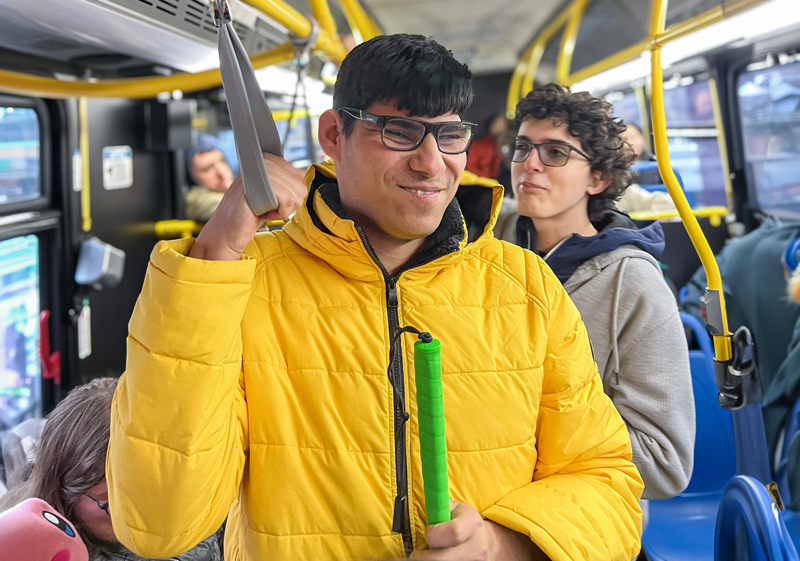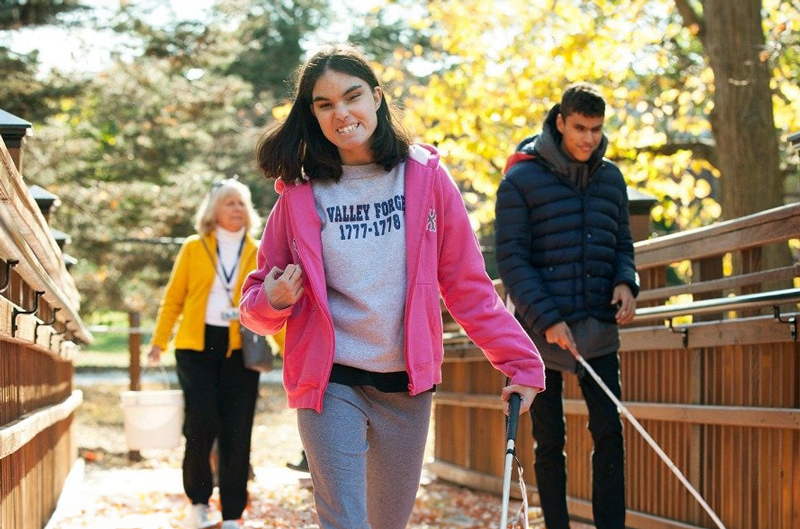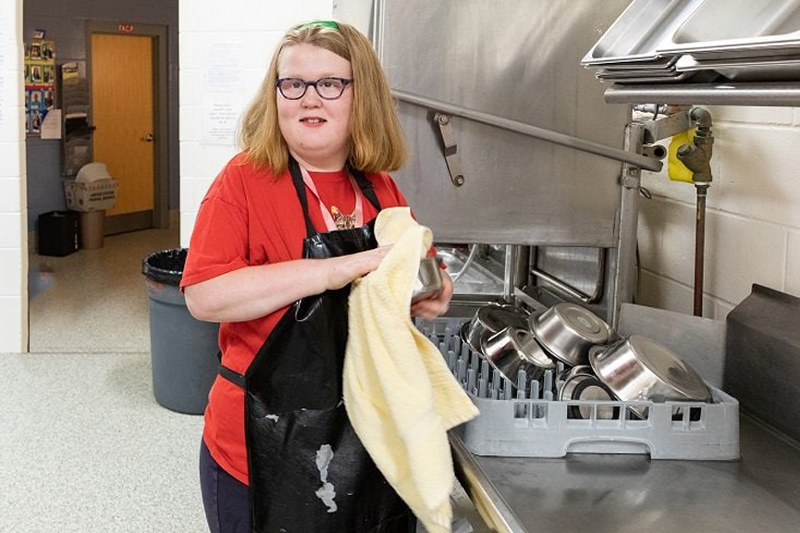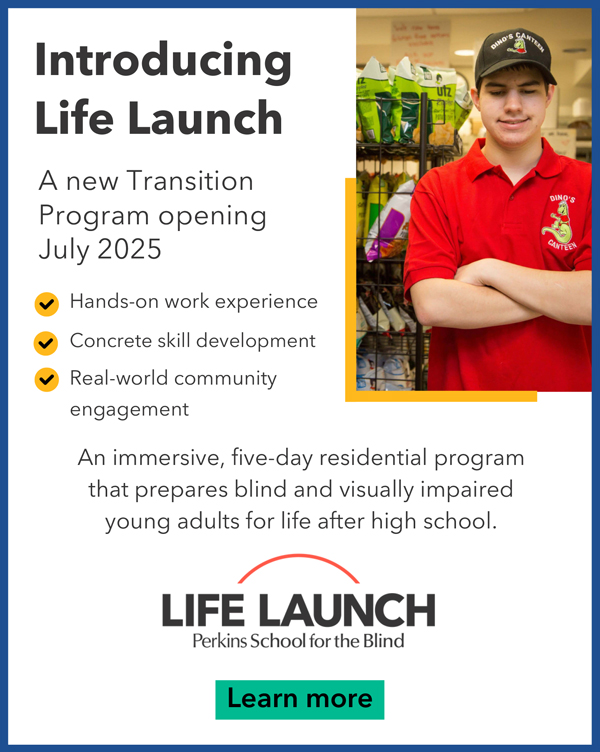VanBergeijk and LaVoie (2024 April & January) established in previous issues of Autism Spectrum News that “autism is the most commonly reported co-existing developmental disorder in children with blindness and other severe visual impairment.” They highlighted the need for a proper differential diagnosis by practitioners who are well-versed in Cerebral/Cortical Impairment (CVI), which is brain-based visual impairment and the leading cause of blindness in children. CVI is often misdiagnosed because autism and CVI have overlapping features (VanBergeijk and LaVoie, 2024, April). Having a child with both a visual impairment and an autism spectrum disorder can be overwhelming for any parent, and even seasoned special educators struggle to develop goals for the future that include the critical skills needed to live as independently as possible. To prepare for life after high school, parents should work together with the school team and students to establish a shared roadmap that reflects the students’ strengths, recognizes areas where support will be needed, and includes social connectedness and community participation.

A young man practices accessing public transportation to travel
Looking Forward, but Working Backwards
Looking forward but working backward refers to a concept VanBergeijk and Cavanagh (2024) explored when referring to residential options for individuals on the autism spectrum. The concept involves developing a shared goal or endpoint that a team of special educators and parents embrace for the student. This goal or vision should be lofty and embody the best possible outcome for the student as they reach young adulthood. Typically, as a part of the Individualized Education Plan (IEP) process, the team identifies goals that revolve around transitioning to the world of work, post-secondary education, and living in the community. The goal is usually set at age 14 and the transition plan is enacted by the time the student is 16 years old. VanBergeijk and Cavanagh (2024) argue that the planning for the student’s future should begin early in the child’s life. Family involvement is key as special educators have a good sense of the academic skills necessary to transition to post-secondary education but do not live with the child to experience their daily routines, strengths, and areas of growth at home and in the community. Also, there is often a tendency to focus on deficits and what the student is not able to do currently. This can lead to a cycle of underestimated potential for young adults with disabilities. Ongoing communication is critical as parents and educators work together with the student to identify strengths and incorporate ambitious goals into the transition plan. Aim high. Dream big.
What Does Independent Living Look Like for a Young Adult on the Autism Spectrum?
This will be different depending upon the environment in which they will transition and the student’s individual interests and goals. We had the privilege of educating a student on the autism spectrum who was non-verbal until he was in the third grade. He ran away from his teachers and school regularly as a young child. His parents and special education team had big dreams for him. The focus was not only on academic skills acquisition but also on the Expanded Core Curriculum, which includes self-advocacy, vocational skills, independent living skills, and social skills. His transition plan included that he attend a Comprehensive Transition and Post-secondary (CTP) program at a college near his home. When he graduated from his CTP, members from his elementary school IEP team attended his graduation. He was the class representative and delivered the commencement address. Today, he lives independently in his own apartment with some drop-in supports. He works as a personal shopper for a national grocery store chain. He regularly boards a train into the city to meet friends for dinner, to see a movie, and to attend Broadway plays. He works out multiple times a week and participates in 5K runs, which raise funds for autism-related causes. Our former student also travels internationally with peers through specialized programs such as Embark Inclusive Travel, Inc.™ He has been to Europe, Central America, and Asia with his peers. By all measures, our student has a good quality of life and has exceeded the expectations of his educators and parents. It is critical that school teams work with young adults to build the practical skills necessary to navigate real-world challenges and foster independence.
How Can Parents and Educators Prepare Young Adults with Autism and Low Vision to Live as Independently as Possible?

A young woman uses a white cane to navigate campus independently
Parents and special educators will need to imagine the student as a young adult navigating through the world. Independent living skills are a series of highly complex building blocks across a variety of domains. These domains include personal hygiene, cooking, cleaning, grocery shopping, budgeting, banking, and managing medical appointments and medications. Organizational skills, first aid skills, traveling to and from work, appointments, and social events also need to be taught explicitly. Developing self-advocacy skills is particularly important as it enables young adults with disabilities to navigate challenges, access resources, and participate fully in their communities. Students need explicit instruction to build the critical self-determination skills needed to apply for a job, advocate appropriate accommodations, and manage their own environment as independently as possible. These skills encompass goal-setting, problem-solving, self-advocacy, and decision-making, all of which contribute to greater independence and confidence.
Financial literacy is essential to living independently in the community and consists of several domains, including earning, spending, saving, and borrowing. These are all higher-level skills that are composed of early building blocks. The IEP for younger children should include the skill of recognizing numbers, simple mathematical operations (e.g., addition, subtraction, multiplication, and division, etc.), and may need to reflect reasonable accommodation of using a calculator in later years. Recognizing denominations of coins and bills will also be important to learning financial literacy. Students who are blind or have low vision may need to learn strategies to recognize coins by size, fold bills of different denominations, and organize them into their wallets. There is also a range of currency readers and applications available that parents can explore with their children.
Money skills are moving away from using cash and checks and migrating toward paying via electronic means. The IEP will need to reflect those means, including using debit cards, money transfer apps, and online banking. This is difficult to teach because the concept of money is abstract. The abstraction is further compounded by the notion of using credit to pay for things. As the child enters high school, parents and educators should work together to provide opportunities for the student to use real money, debit cards, and applications to pay for items and activities outside of the school and at home. A crucial component of this is teaching students how to protect personal information and prevention strategies to avoid being a victim of financial fraud. As the team continues to identify goals for the future, they may realize the student will need additional support in this domain even after years of effort and interventions. Here, parents can aid special educators in identifying these resources by inviting state social service agencies to IEP meetings during the transition age years. State agencies like the Commission for the Blind offer Vocational Rehabilitation Services that provide additional community resources and training.

A student explores a new job opportunity washing dishes in an industrial kitchen.
The ability to travel independently in the community is another critical skill to living and working as independently as possible. Orientation and mobility specialists are trained professionals who teach individuals who are blind or visually impaired how to navigate environments safely and confidently. The transition plan should include mobility goals, with a focus on gaining comfort, exploring the community, and making connections. This can be done in a myriad of ways that are fun and exciting but will depend upon the interests, aptitudes, and strengths of the student. Goals can be developed that include traveling to work and recreational outings, as well as using public transportation. Recreational activities can consist of things like adaptive horseback riding, ice skating, swimming, biking, and canoeing. There are numerous adventure education and adapted physical education groups across the country that are available to provide resources and support. Exploring the community can also include going to the grocery store and accessing the public library. Parents can support the work of the schools in this area where the student takes the lead in planning outings for the family using public transportation during nights, weekends, and school breaks.
For young adults whose goals are around post-secondary education and living away from home, getting the student used to separating from the family will be important. Sleep-away summer camps are an excellent way to help with the process. In fact, one study showed that campers with autism showed significant improvements in prosocial behaviors, maladaptive social behaviors, and autism-consistent behaviors (Brodoff, 2017). The American Camping Association has over 11,000 programs in its database. These include day and overnight camps and even family or adult camps, many of which serve students with a range of disabilities, including autism, blindness, and low vision. Summer programs and social experiences outside of the home and school build confidence, encourage friendships, and promote the development of critical independent living skills. For students with extended-year services, a summer transition program can be written into their IEP if it supports their transition plan goals.
A New Transition Program for Students with CVI, Low Vision, and Co-occurring Conditions
Perkins School for the Blind has been helping students with disabilities find their place in the world for almost 200 years. Working with local educational agencies, special educators, parents, and students, the Perkins faculty and staff design individualized programming that meets the needs of the range of student profiles that they serve. Next year, Perkins will open an innovative new transition program that addresses the critical gap in our educational landscape for intensive transition programming for young adults with complex disabilities. Life Launch is a multi-year residential program that prepares young adults who are visually impaired with multiple disabilities for independent living through hands-on work experience, concrete skill development, and real-world community engagement. The Life Launch Program will welcome the first class of students to campus in July 2025. For more information or to apply, visit: www.perkins.org/transition-center/life-launch/
Perkins also offers individualized transition counseling for families and a range of impactful programming and resources. The Transition Center offers a digital library that includes downloadable tools, virtual events, and practical information on a variety of transition-related topics, including college alternatives, housing, person-centered planning, and guardianship. For more information on these programs and resources, visit: www.perkins.org/transition-center.
Ernst VanBergeijk, Ph.D., M.S.W. is the Founder and President of Ernst Equitable Education Solutions, a consulting firm that helps parents find appropriate educational settings and solutions for their children, and helps organizations evaluate and design programming for special needs children, youth, and young adults. He has over 35 years of experience in the special education field including working as the executive director/dean of two college-based transition programs for students with a wide variety of disabilities. Dr. VanBergeijk was recently appointed as the Senior Director, Local Education Agency, Early Learning Services, Elwyn. Elwyn is the oldest and largest agency of its kind serving the I/DD population.
Alexandra LaVoie, MSOT is the Director of the Transition Center at the Perkins School for the Blind and is a licensed occupational therapist and special education administrator. Alex has worked in the field of blindness education for over 10 years and has a deep understanding of the unique supports and accommodations that are needed for BVI students to achieve their post-secondary goals. She is passionate about Perkins’ mission to empower students with disabilities to unlock their potential and live as independently as possible.
References
American Camping Association (2024). Find A Camp. Retrieved from: find.acacamps.org/ June 7, 2024.
Brodoff, R. (2017). Examining the Effectiveness of a Summer Camp for Improving the Social Skills and Self-Regulation Behaviors in Children With Autism Spectrum Disorder. Widener University ProQuest Dissertation & Theses, 2017. 10286756.
Cavanagh, P.K. and VanBergeijk, E.O. (2013). Transition plans for students with autism and other intellectual disabilities. Pp. 875-887. In C. Franklin, M.B. Harris, & P.A. Meares (Eds.), School services sourcebook (2nd ed.). New York: Oxford University Press. books.google.com/books?hl=en&lr=&id=FuNoAgAAQBAJ&oi=fnd&pg=PP1&dq=vanbergeijk+ernst&ots=KiLUq_dzbx&sig=16PNk6jvaIcVR35ED2tb3_9z5S0 – v=onepage&q=vanbergeijk ernst&f=false
Federal Student Aid (2024). Students with Intellectual Disabilities. Retrieved from: studentaid.gov/understand-aid/eligibility/requirements/intellectual-disabilities June 7, 2024.
VanBergeijk, E.O. and Cavanagh, P.K. (2024). Residential options and treatment for individuals on the autism spectrum, pp. 249-274. In McPartland, J., Reichow, B. and Volkmar, F.R. (Eds.). Adolescents and adults with autism spectrum disorders. 2nd ed. New York: Springer. DOI: doi.org/10.1007/978-3-031-46463-8
VanBergeijk, E.O., and LaVoie, A. (2024, April,). Autism Spectrum News, 16 (4): pp. 9,14. Understanding Insurance Coverage for Autism and Co-Occurring Visual Impairment. autismspectrumnews.org/understanding-insurance-coverage-for-autism-and-co-occurring-visual-impairment/
VanBergeijk, E.O. and LaVoie, A. (2024, January). Helping Youth with Autism and Low Vision and Blindness. Autism Spectrum News,
autismspectrumnews.org/helping-youth-with-autism-and-co-occurring-low-vision-and-blindness/
VanBergeijk, E.O. (2020, April). Using Summer Programming to Prepare for Post-Secondary Education. Autism Spectrum News, autismspectrumnews.org/using-summer-programming-to-prepare-for-post-secondary-education/








